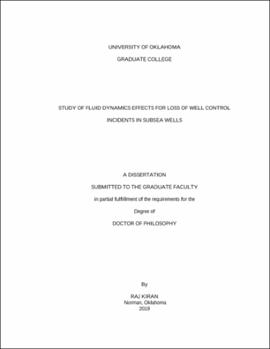| dc.contributor.advisor | Salehi, Saeed | |
| dc.contributor.author | Kiran, Raj | |
| dc.date.accessioned | 2019-05-10T18:18:07Z | |
| dc.date.available | 2019-05-10T18:18:07Z | |
| dc.date.issued | 2019-05-10 | |
| dc.identifier.uri | https://hdl.handle.net/11244/319699 | |
| dc.description.abstract | The safety of well operations has become the focal point of the research paradigm since the Deepwater Horizon incident. The risks of wellbore blowouts cannot be neglected in any drilling operation, which makes the discharge of fluids a likely scenario. One of the critical observations while tackling the well control operation during the Deepwater Horizon incident was the fluid discharge rate with subsonic and sonic velocity. Lack of a comprehensive tool to estimate the worst-case discharge scenario constrained the tackling operations and exacerbated the side effects of blowouts. Keeping this in mind, an experimental and numerical investigation of multiphase flow was conducted, and consequently, an integrated reservoir and hydrodynamic model was developed to estimate the worst-case discharge (WCD).
A new multiphase vertical flow-loop was constructed, which included annulus and pipe as test sections. The flow loop was equipped with sensors and instruments to capture the flow characteristics. The experiments were conducted at high superficial gas (0-160m/s) and liquid velocity (0-2.35 m/s) to measure the pressure drop and liquid holdup. The high-speed video recording was implemented to capture the photographic images of flow dynamics. Experimental data were analyzed to understand the flow characteristics during high-velocity inlet conditions. Numerical investigations were carried out using computational fluid dynamics (CFD) and mechanistic modeling to mimic the experimental data.
The experimental results show the friction dominated trend of pressure gradients. The CFD modeling in ANSYS Fluent suggests that the volume of fluid multiphase flow model with different turbulence models can identify the flow regimes in high-velocity flow conditions. Furthermore, several mechanistic and empirical models were tested to verify the aptness in WCD estimation. Finally, the suitable hydrodynamic model was incorporated in the newly developed tool to characterize the discharge rates. A new sonic correlation was developed based on which it can be established whether the sonic condition achieved in the well or not. These features were included in an integrated hydrodynamic and reservoir tool that can simulate the real-time event of WCD scenario. A sensitivity analysis was conducted to establish confidence in the software. The results were in good agreement with the commercial software in the base cases.
The novelty in this approach is the integrated use of numerical and experimental investigation to mimic the real field conditions of WCD especially for flow with Mach number greater than 0.3 (subsonic and sonic conditions). The new models and techniques can be used in flow characterization of high superficial gas velocity multiphase flow and estimation of flow rates during the worst case discharge. | en_US |
| dc.language | en_US | en_US |
| dc.rights | Attribution-NonCommercial-NoDerivatives 4.0 International | * |
| dc.rights.uri | https://creativecommons.org/licenses/by-nc-nd/4.0/ | * |
| dc.subject | Petroleum | en_US |
| dc.subject | Worst case discharge | en_US |
| dc.subject | Multiphase flow | en_US |
| dc.subject | Annulus | en_US |
| dc.title | STUDY OF FLUID DYNAMICS EFFECTS FOR LOSS OF WELL CONTROL INCIDENTS IN SUBSEA WELLS | en_US |
| dc.contributor.committeeMember | Vedula, Prakash | |
| dc.contributor.committeeMember | Ahmed, Ramadan | |
| dc.contributor.committeeMember | Teodoriu, Catalin | |
| dc.contributor.committeeMember | Misra, Siddharth | |
| dc.date.manuscript | 2019-05-10 | |
| dc.thesis.degree | Ph.D. | en_US |
| ou.group | Mewbourne College of Earth and Energy::Mewbourne School of Petroleum and Geological Engineering | en_US |
| shareok.nativefileaccess | restricted | en_US |

